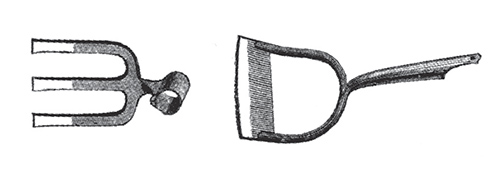
This Article From Issue
November-December 2014
Volume 102, Number 6
Page 472
DOI: 10.1511/2014.111.472
A HISTORY OF THE GARDEN IN FIFTY TOOLS. Bill Laws. 224 pp. University of Chicago Press, 2014. $25.00.
In A History of the Garden in Fifty Tools, Bill Laws—a writer whose previous books include the fetchingly titled The Field Guide to Fields—approaches his subject with a disarming mixture of deliberation and affection. His tales ramble from the 20th century to the Paleolithic era and back again to recount global histories of, yes, 50 garden tools, each offered up in all its staggering variety. The scale of such a project could have been overwhelming, but the book’s artfully cohesive design makes it accessible and orderly. The text is divided into five richly illustrated sections (the flower garden, the vegetable garden, the lawn, the orchard, and structures and accessories); each chapter within a given section focuses on a single implement.

From A History of the Garden in Fifty Tools.
The tools that Laws has chosen as his subjects also reflect a mix of rigor and impulsiveness. The expected implements are here (spade, hoe, garden fork, rake) along with related historical details about metallurgy, design, and use. Yet unconventional tool choices are sprinkled throughout, including the calendar, the garden journal, and Latin. “Latin may not fall into the more obvious category of physical tools,” Laws notes. “Nevertheless, it provides the gardener with an accurate and unique description of every plant and a language that can be shared and understood by gardeners from Kazakhstan to Kentucky.” Even the radio gets a turn. Laws nods to the utility of shows such as BBC’s indefatigable Gardener’s Question Time but dwells mostly on ways sound has been incorporated in the garden (in pre-radio days with the likes of wind chimes and water-powered organs) and on experiments discerning whether plants respond to sound. Conventional or not, each tool allows Laws to meditate more deeply on the broader culture of horticulture.
This, in fact, is what he does best. The chapter on garden baskets describes how their construction differs from culture to culture according to use and local materials, ranging from oak splits to bamboo strips to palm leaves—even sailcloth remnants in seafaring communities. Irish craftspeople have made prolific use of abundant, pliable willow branches, weaving them into baskets, baby rattles, dog muzzles, and potato plates, among other handy items. The chapter on scarecrows also reveals a surprising diversity of construction. Japanese kakashi, for instance, were designed to be both visually off-putting and malodorous, made of rags accessorized with burning offal that issued a smelly smoke. Laws then considers how scarecrows, intended to ward off pests, have come to be regarded as ominous figures, tugging insistently at the psyches of their creators.
In a letter to American portrait painter Charles Wilson Peale, Thomas Jefferson famously said, “tho’ an old man, I am but a young gardener.” Lush and diverting, contained and extemporaneous, A History of the Garden in Fifty Tools may be nearly as invigorating as gardening itself.
Dianne Timblin is interim book review editor for American Scientist and author of the poetry chapbook A History of Fire (Three Count Pour, 2013). Find her on Twitter: @diannetimblin.
American Scientist Comments and Discussion
To discuss our articles or comment on them, please share them and tag American Scientist on social media platforms. Here are links to our profiles on Twitter, Facebook, and LinkedIn.
If we re-share your post, we will moderate comments/discussion following our comments policy.